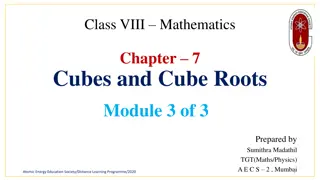Understanding Plant Roots: Anatomy, Functions, and Types
Delve into the world of plant roots and explore their anatomy, functions, and different types such as taproot and fibrous root systems. Discover how roots absorb water and minerals, anchor plants in the ground, transport nutrients, and store food. Learn about the primary and secondary root structures, apical meristem, root hairs, and internal layers like cortex and endodermis.
Uploaded on Nov 26, 2024 | 0 Views
Download Presentation

Please find below an Image/Link to download the presentation.
The content on the website is provided AS IS for your information and personal use only. It may not be sold, licensed, or shared on other websites without obtaining consent from the author. Download presentation by click this link. If you encounter any issues during the download, it is possible that the publisher has removed the file from their server.
E N D
Presentation Transcript
Root Anatomy Root Anatomy 2019-2020 2NDGRADE HANNAH KEMAL HANNAH.KEMAL@ISHIK.EDU.IQ
Objectives Objectives Define Plant root List the functions of the root system Describe the types of root systems Identify the parts of roots
What is A Plant Root? What is A Plant Root? The organ of the plant that lies typically underground to convey water and nutrients to the rest of the plant
Functions of the Root System Functions of the Root System Absorbs water and minerals from the environment Anchors the plant in the ground Transports water and minerals to the stem Stores food that has been made in the leaves by photosynthesis
Types of Root Systems Types of Root Systems 1. Taproot System A root system that comprises of one primary root and several secondary roots branching off the primary root. Examples: Carrots Beets
Types of Root Systems Types of Root Systems 2. Fibrous Root System A root system that has several primary and secondary roots of similar size Examples: Grass Onion
Parts of the Root Parts of the Root Primary Root Usually the most important (main) root in some plants Secondary Root Roots that branch out from the primary root Apical Meristem Found at the root tip where new cells develop Covered by the Root Cap protects it from damage as it passes through coarse soil particles Epidermis Skin cells that protect the surface of the root Can grow long hair-like projections called Root Hairs (Increase the surface area of root for more water uptake)
Internal Root Layers Internal Root Layers 1. Cortex This is where the root stores the food that is produced by the leaves Made of Parenchyma tissue 2. Endodermis Controls the movement of water and minerals into the xylem and phloem Inner boundary of the cortex 3. Pericycle A layer found inside the endodermis that may produce lateral roots
4. Vascular Cylinder (Stele) Forms the central cylinder of the root It is made of two secondary transport tissues: 1. Xylem Carries the water, taken in by the root hairs and epidermis, up the plant to the stems and leaves 2. Phloem Carries the food produced by the leaves down to the roots to be stored in the cortex
Dicot vs. Monocot Roots Dicot vs. Monocot Roots
Thank You! Thank You!























